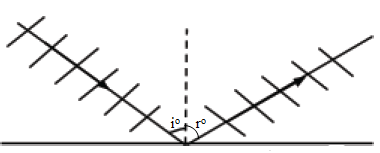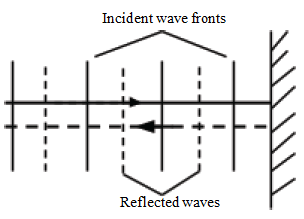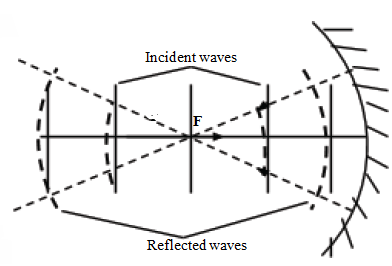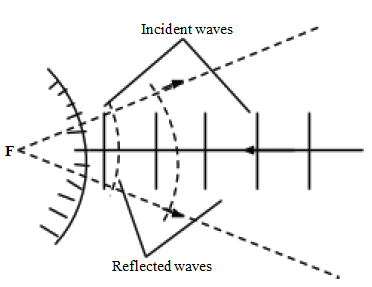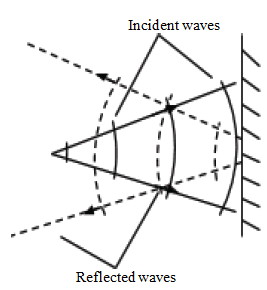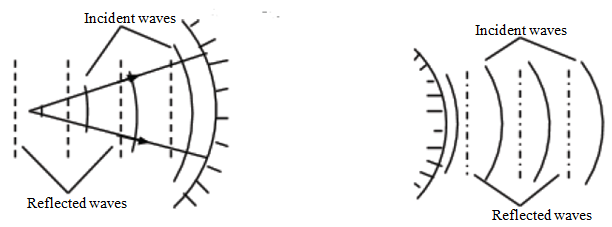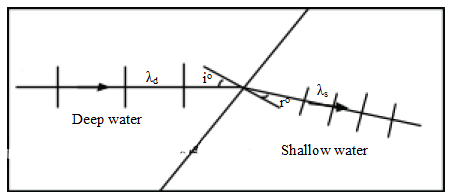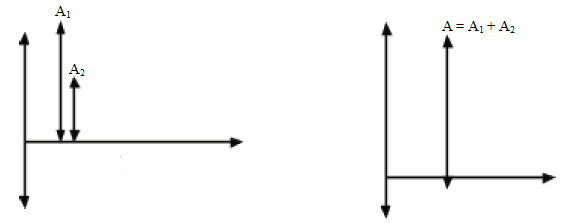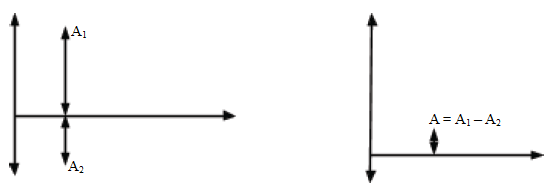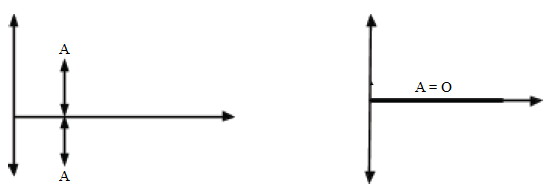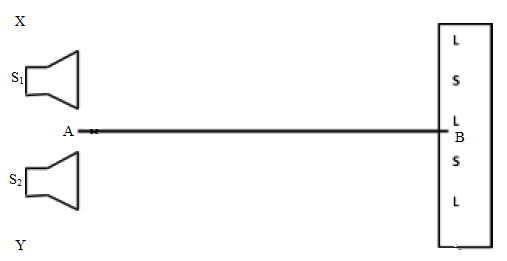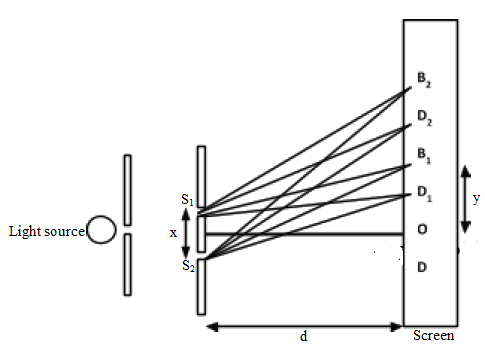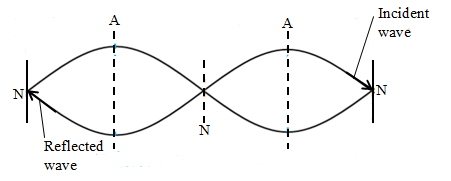
Introduction
- A wave is a transfer of energy through a medium from one point to another. Some examples of waves include; water waves, sound waves, and radio waves.
- Waves come in two different forms; a Transverse Wave which moves the medium perpendicular to the wave motion, and a Longitudinal Wave, which moves the medium parallel to the wave motion.


Properties of Waves
- Wave properties refer to the behaviour of waves under certain conditions.
- They include
- Reflection,
- Refraction,
- Diffraction and
- Interference among others.
- They can be investigated using a ripple tank which consists of a transparent tray containing water, a lamp for illumination, a white screen underneath and an electric motor (a vibrator). The motor is connected to a straight bar which produces straight waves. If circular waves are required, the bar is raised and a small spherical ball fitted to it to produce circular waves. To view the waves with ease, a stroboscope is used. A stroboscope is a disc having equally spaced slits. It is rotated and its speed controlled such that the waves appear stationary i.e frozen.
Reflection of Waves
- All waves undergo reflection. It is the bouncing back of waves when they hit an obstacle.
- All waves undergoing reflection obey the laws of reflection as earlier stated.
- Note that the wavelength of the waves remains unchanged. The pattern of the reflected waves depends on the shape of the incident waves and the reflector.
- Below are some patterns:
- Plane waves incident on a straight reflector
- Plane waves incident on a concave reflector
The waves converge at the principal focus F after reflection. - Plane waves incident on a convex reflector
The reflected waves appear to be diverging from a point (principal focus) behind the reflector. - Circular waves incident on a straight reflector
The reflected waves diverge away from the reflector. - Circular waves incident on a concave/convex reflector
- Plane waves incident on a straight reflector
Refraction of Waves
- This is the bending of waves as they travel from one medium into another.
- In the process, the speed of the waves changes from one medium to another.
- In the case of water waves, refraction occurs as the waves move from a region of a certain depth into another region of a different depth i.e. from a shallow region to a deeper region or vice versa.
- In general, the speed of water waves is greater in a deeper region than in a shallow region. It is important to note that the source of waves remains the same regardless of the depth thereafter. Hence, the frequency of the waves is a constant.
Recall: wave speed= frequency, f × wavelength, λ. - From the equation, it is clear that when the wave speed increases the wavelength also increases and vice versa.
Thus, the wavelength is longer in deeper regions than in shallow regions. - To obtain a shallow region in a ripple tank, a transparent glass block is placed in the tank with one end of its edge parallel to the vibrating bar.
- However, when the waves strike the boundary normally/perpendicularly, no bending occurs even though the speed and hence the wavelength changes.
- Refraction of sound waves can be used to explain the long range of sound at night compared to daytime. This has been explained in the ‘topic refraction of light’. TV and radio signals from a distant station also undergo a series of refraction and total internal reflection in the ionosphere towards the earth’s surface making their reception possible.
Diffraction of Waves
- Diffraction may be defined as the spreading of waves behind an obstacle.
- When the aperture is nearly the same size as the wavelength of the waves, the waves emerge as circular waves spreading out around the obstacle as shown in (a) below.
- However, when the size of the aperture is relatively wider than the wavelength of the waves, the waves pass through as plane waves bending slightly at the edges as shown in (b).
- Diffraction of sound waves can be used to explain why sound within a room can be heard round a corner without necessarily having to see the source of the sound.
- Diffraction of light waves is not a common occurrence due to their shorter wavelengths. Nevertheless, diffraction of light waves can be observed when light pass through a small opening at the roof of a dark room.
- A shadow which is broader than the opening forms on the floor of the room.
Interference of Waves
- Interference occurs when two waves merge. Such a merger may give rise to three cases:
- A much larger wave is formed i.e. constructive interference.
The waves are in phase and superimpose to produce a wave with a greateramplitude. - A smaller wave is formed i.e. destructive interference.
The waves are out of phase with a phase difference of 180o . Since they have different amplitudes, they superimpose to form a wave with a smaller amplitude. - A stationary wave.
When the two waves which are out of phase with a phase difference of 180o superimpose, the result is a stationary wave having a zero amplitude.
- A much larger wave is formed i.e. constructive interference.
- Interference is a product of the principle of superposition which states: for two waves travelling in at a given point in the same medium, the resultant effect is the vector sum of their respective displacements.
- Interference of water waves can be shown by setting up two spherical dippers in a ripple tank which simultaneously generate waves. Alternating dark and bright radial lines will be observed on the screen representing regions of constructive and destructive interference respectively.
- For interference to occur there ought to be a coherent source i.e. a source that generates waves of the same frequency and wavelength, equal or comparable amplitudes and having a constant phase difference.
- Interference of sound waves can be investigated by the set up below:
- Two loudspeakers S1 and S2 connected to an audio-frequency generator act as a coherent source. To an observer walking along a straight path XY, alternating loud and soft sound is heard. Along the line AB, a constant loud sound will be heard.
- The regions with loud sound represent areas of constructive interference while the regions with soft sound represent areas of destructive interference. When the frequency of the signal is increased, the separation between the alternating loud and soft sound is reduced i.e. more close. Note that for a signal of any velocity, the higher the frequency the shorter the wavelength.
- If instead the loudspeakers are connected such that the waves generated by one loudspeaker are exactly out of phase with those from the other, then all points along XY will have destructive interference and hence soft sound is heard throughout.
- Interference of light waves- this can be demonstrated by the Young’s double slit experiment. Two narrow and very close slits S1 and S2 are placed infront of a monochromatic light source.
- The light waves from the two slits undergo diffraction and superimpose as they spread out. A series of alternating bright and dark fringes are observed on the screen. The bright fringes are due to constructive interference while the dark fringes are due to destructive interference. However, along the central line through the centre of the slits and point O, it is bright throughout.
- At O, the path difference of the two waves is zero since S1O=S2O. Moving upwards or downwards to the first bright fringe, the path difference is equivalent to one wavelength; i.e S2B1 − S1B1 = 1λ
- At D1 , the path difference is equivalent to half a wavelength;
S2D1 − S1D1 = 1/2λ - Similarly, at the second bright fringe B 2 , the path difference is equivalent to two wavelengths;
i.e S2B2 − S1B2 = 2λ
And S2D2 − S1D2 = 3/2λ - Generally, at the n th bright fringe, the path difference will be n times the wavelength;
S2Bn − S1Bn = nλ - The wavelength of the light used can also be determined from the expression below:
λ= xy/d,
Where
x- the slit separation,
y- Distance between successive bright fringes and
d- Perpendicular distance of the slits from the screen.

Stationary Waves versus Progressive Waves
- A progressive wave is a wave that continuously moves away from the source.
- When two progressive waves equal in amplitude and travelling in opposite directions superpose on each other, the resultant wave is referred to as a stationary or standing wave.
- It is a common occurrence in stringed instruments. When the string is plucked/played, a transverse wave travels along the string and is reflected back on reaching the other end of the string.
- The points marked N are always at rest (zero displacement) and are called nodes while those marked A are where the wave has maximum amplitude (maximum displacement). They are called antinodes.
- When two loudspeakers connected to the same audio-frequency generator are such that they face each other, then the two sound waves superpose to produce a stationary wave.
- For two progressive waves to produce a stationary wave, the following conditions must be satisfied:
- They must be travelling in opposite directions.
- Must have same speed, frequency and same or nearly the same amplitudes. - The following table gives the comparison between a stationary and a progressive wave:
Stationary waves Progressive waves Do not move through the medium hence does not tranfer any energy from the source Move through the medium transferring energy from the source to a point away The distance between successive modes or antinodes is equal to 1/2 λ The distance between successive crests or troughs is equal to the wavelength of the wave The amplitudes of particles between successive nodes are different. The amplitudes of any two particles which are in phase are the same
Join our whatsapp group for latest updates
Tap Here to Download for 50/-
Get on WhatsApp for 50/-
Download WAVES 2 - Form 3 Physics Notes.
Tap Here to Download for 50/-
Get on WhatsApp for 50/-
Why download?
- ✔ To read offline at any time.
- ✔ To Print at your convenience
- ✔ Share Easily with Friends / Students

